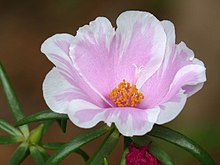en
names in breadcrumbs


The Portulacaceae are a family of flowering plants, comprising 115 species in a single genus Portulaca.[2] Formerly some 20 genera with about 500 species, were placed there, but it is now restricted to encompass only one genus, the other genera being placed elsewhere. The family has been recognised by most taxonomists, and is also known as the purslane family. It has a cosmopolitan distribution, with the highest diversity in semiarid regions of the Southern Hemisphere in Africa, Australia, and South America, but with a few species also extending north into Arctic regions. The family is very similar to the Caryophyllaceae, differing in the calyx, which has only two sepals.
The APG II system (2003; unchanged from the APG system of 1998) assigns it to the order Caryophyllales in the clade core eudicots. In the APG III system, several genera were moved to the Montiaceae, Didiereaceae, Anacampserotaceae and Talinaceae, thus making the family monotypic and only containing the genus Portulaca.[1]

The following species are accepted:[3]
Common purslane (Portulaca oleracea) is widely consumed as an edible plant, and in some areas it is invasive. Portulaca grandiflora is a well-known ornamental garden plant. Purslanes are relished by chickens. Some Portulaca species are used as food plants by the larvae of some Lepidoptera species including the nutmeg moth (Hadula trifolii).
Pickled purslane stems consumed in Armenia
The Portulacaceae are a family of flowering plants, comprising 115 species in a single genus Portulaca. Formerly some 20 genera with about 500 species, were placed there, but it is now restricted to encompass only one genus, the other genera being placed elsewhere. The family has been recognised by most taxonomists, and is also known as the purslane family. It has a cosmopolitan distribution, with the highest diversity in semiarid regions of the Southern Hemisphere in Africa, Australia, and South America, but with a few species also extending north into Arctic regions. The family is very similar to the Caryophyllaceae, differing in the calyx, which has only two sepals.
The APG II system (2003; unchanged from the APG system of 1998) assigns it to the order Caryophyllales in the clade core eudicots. In the APG III system, several genera were moved to the Montiaceae, Didiereaceae, Anacampserotaceae and Talinaceae, thus making the family monotypic and only containing the genus Portulaca.
 Portulaca 'All Aglow'
Portulaca 'All Aglow'  Portulaca grandiflora 'Bicolor'
Portulaca grandiflora 'Bicolor'